
2. Centre for Ore Deposit and Exploration Science, University of Tasmania, Private Bag 79, Hobart, Tasmania 7001
2. Centre for Ore Deposit and Exploration Science, University of Tasmania, Private Bag 79, Hobart, Tasmania 7001, Australia
近年来,随着扫描电镜,激光剥蚀电感耦合等离子质谱技术(LA-ICPMS),短波近红外光谱分析技术以及其它微区分析技术的飞速发展,矿物原位微量元素组成研究逐渐成为地球科学领域的研究热点。大量的研究成果表明,矿物原位微量元素的组成可以用于判断元素在矿物中的赋存状态,约束岩石的形成时代和形成环境,探讨微量元素在地质事件不同阶段的活化迁移行为,从而反演成矿流体的演化,示踪成矿物质来源,阐明矿床成因(周涛发等, 2010; Large et al., 2007, 2009, 2014; Woodhead et al., 2009; Lin et al., 2011; Cooke et al., 2013, 2014a, b; Audétat et al., 1998; Ulrich et al., 1999; Wilkinson et al., 2009; Kouzmanov and Pokrovski, 2012; Marsala et al., 2013; Meffre et al., 2008; Agangi et al., 2013; Gregory et al., 2015a, b; Wilkinson et al., 2015)。同时,在矿产勘查领域,矿物原位微量元素在矿产勘查方面的应用研究成果始于对斑岩-浅成低温热液系统的研究,并取得了一大批革命性的优秀成果。通过矿物微量元素组成在空间上的分布规律研究指导矿产勘查,已经成为国际矿业公司的常规必备勘查手段。最新勘查成果证实,通过矿物中某些微量元素的灵敏变化来帮助识别具有成矿潜力的成矿带,指示矿化中心的方向,估算距离矿化中心的距离等,具有良好的找矿效果。斑岩系统相关的铜,金,银,钼和铅锌等矿床是目前全球矿业勘探的热点,同时也是全球黄金资源的重要来源。由于出露于地表的这类矿床基本上都已被发现,下一步的找矿勘查工作目标均为地表之下的深部隐伏矿床,也即我国近年提出的“攻深找盲”、“第二深度空间找矿”(滕吉文, 2006)。
先进的地球物理勘探技术和深部钻探为隐伏矿床的发现提供了极大的帮助,但这些方法的成本相对巨大,而且耗时较长。传统的地球化学勘探方法对深部隐伏矿床的勘查又帮助甚微,其原因在于,原生地球化学晕被后期的表生作用破坏,或者被非矿化的表层所覆盖。因而,当面临热带雨林地区、沙漠地区和深覆盖区时,这些传统勘探方法很难提供清晰的勘探方向,我们急需其它的方法手段来进行协助。针对这一现实问题,一个新兴的研究方向“矿物地球化学找矿”迅速崛起。近年来在该方面所涌现的重要研究成果包括:利用一些岩浆结晶矿物的元素组成来识别出具有成矿潜力的成矿带或者成矿区(Dilles et al., 2015; Shen et al., 2015; Williamson et al., 2016; Bouzari et al., 2016);当选定具有潜力的成矿区之后,利用热液蚀变矿物,如绿帘石、绿泥石、磁铁矿和明矾石等来帮助进一步预测潜在的矿化中心的方向和大致位置,以及对矿化规模进行评估。在该领域,澳大利亚塔斯马尼亚大学国家矿床研究中心(CODES)的团队已经开展了十多年的相关研究。在澳大利亚国际矿业协会(AMIRA)的资助下,自2003年以来,该团队先后完成了多个国际重大研究项目,这些项目由多达21家国际大型矿业集团共同资助。项目研究成果直接改变了矿业公司找寻斑岩和浅成低温热液矿床的勘探方法(Chang et al., 2011; Cooke et al., 2014a, b, 2015, 2017; Wilkinson et al., 2015, 2017; Baker et al., 2017; Xiao et al., 2017)。CODES团队还开发了一系列地球化学方法来识别不同的热液环境(如斑岩、浅成低温和变质等),并且在成矿规模判别方面(例如,区分大型,小型和贫矿系统)也取得了重要进展。近年来,同类应用研究已逐渐拓展到了其它类型的热液成矿系统(如矽卡岩,VHMS,IOCG等),同时取得了重大突破。
本文较为系统的总结了应用矿物微区微量元素组成研究岩石和矿床的成因、成矿潜力区带的识别,矿化中心位置的预测等相关研究的最新进展,重点强调了这些新的研究成果和相关的分析技术在岩浆热液矿床,尤其是斑岩矿床找矿勘探方面的应用成果,旨在为我国开展相关方面的研究提供参考信息,为矿床勘探和矿床成因研究提供新的思路。
1 LA-ICPMS矿物原位微量元素分析技术的发展矿物原位微量元素组成的研究离不开激光剥蚀电感耦合等离子体质谱(laser ablation inductively coupled plasma mass spectrometry,即LA-ICPMS)技术的飞速发展。激光剥蚀电感耦合等离子体质谱技术是20世纪80年代发展起来的一项分析检测技术。英国Surrey大学的Alan Gray是第一个提出并实践将激光剥蚀系统(laser ablation,简称LA)与电感耦合等离子质谱仪(inductively coupled plasma mass spectrometry,简称ICPMS)进行结合和进行化学分析的学者(Gray, 1985)。这种分析技术目前被认为是最为有效的一种分析不同物质中的微量元素和同位素的一种手段。在过去的30年,已经有超过500篇的相关论文和著作从不同的角度和学科讨论和描述了该方法的基本原理以及在化学分析中的广泛应用(Castro et al., 2010; Koch and Günther, 2011; 刘勇胜等, 2013; 汪方跃等, 2017)。该方法在地球科学领域的应用更是极为普遍,其基本原理是将激光束聚焦于样品表面使其熔蚀、气化,并由载气(He或Ar)将样品微粒(气溶胶)送至等离子体中电离,再经质谱系统进行质量过滤,最后由接收器分别检测不同荷质比的离子(刘勇胜等, 2013)。该技术可实现在5~10μm空间分辨率下对硫化物矿物的直接剥蚀进样,且灵敏度高、检出限低(可低至10-9水平)、可实现多元素同时检测。除了进行单点的原位分析测试以外,还可以利用该方法进行二维或者三维的元素或同位素组成的面扫描(“mapping”)(图 1)。最近,汪方跃等(2017)基于PhotonMachines激光剥蚀系统与安捷伦ICP-MS开发了矿物元素面扫描分析新方法,具有面扫描分析时间短,操作简单,并具有多种数据显示模式和剖面切割展示,元素比值面分布分析等优势。更为详细的分析测试方法以及相关的软件、硬件设备的描述可参见参考文献Woodhead et al. (2016)、Müller and Fietzke (2016)。我国已有若干大学和研究机构已经建立了比较成熟的LA-ICPMS矿物原位微量元素分析实验室,如中国地质大学(武汉)、中国科学院地质与地球物理研究所、中国地质科学院矿产资源研究所、合肥工业大学等。

|
图 1 展示用LA-ICPMS对硫化物进行激光面扫描的能力以及LA-ICPMS数据的各种表现方法 四幅图所展示的是对同一区域进行分析的结果.(a)对由不同矿物颗粒组成的样品进行先扫描分析的时间和信号分辨强度图;(b) 12幅含有13个元素的激光面扫描元素组成二维图像;(c、d)两个3D组成图,可用于从LA-ICPMS数据中提取重要的化学组成信息(例如显微矿物包体在样品中的分布) Fig. 1 Demonstration of the capabilities of LA-ICPMS for laser imaging of sulphide minerals and the various ways that LA-ICPMS data can be depicted All four plots refer to the same area. (a) time-resolved intensity plots of line scans across composite mineral grains; (b) twelve 2-Dcompositional maps for 13 elements; (c, d) two 3-Dcompositional maps, which can be used to 'pull out' chemical information (e.g. the distributions of elusive micro nuggets) from time-resolved LA-ICPMS data |
矿物高精度微量元素组成最初多被运用到岩石和矿床成因机制的探讨中。在研究岩石成因方面,锆石和磷灰石一直是被重点关注的对象。自从20世纪80年代开始,锆石U-Pb定年就一直被用来约束岩石的形成年龄,推动了地球科学的巨大发展。除了定年之外,锆石中的部分痕量元素组成或元素比值(如REE、Th/U等)也被用来进行判别锆石的形成环境(Geisler et al., 2007; Rubatto and Hermann, 2007; Scherer et al., 2007; 杨甫等, 2016)。锆石地质温度计能够有效的计算岩浆岩的形成温度(von Quadt et al., 2011; Chiaradia et al., 2013),同时锆石的同位素组成和微量元素组成可以用来有效的反演岩石的成因。锆石微量元素组成的研究主要集中在以下几方面:(1)通过Ce和Eu异常来了解岩浆的氧化态(Ballard et al., 2002; Hoskin and Schaltegger, 2003; Burnham and Berry, 2012; Dilles et al., 2015; Shen et al., 2015);(2)通过Ti的含量计算锆石的结晶温度(Ferry and Watson, 2007; Watson and Harrison, 2005);(3)通过Zr/Hf、U、Th和REE的配分形式来反演岩浆成分的变化(Claiborne et al., 2006; Kemp et al., 2007)。
磷灰石是另外一个重要的研究对象。磷灰石可以形成于火山岩、变质岩、沉积岩和热液环境。通常情况下,磷灰石作为副矿物的形式少量存在,但有时候磷灰石也可以作为重要的造岩矿物形成沉积型磷灰岩以及岩浆成因的磁铁矿-磷灰石矿床(Martin and Rakovan, 2013; Harlov, 2015)。磷灰石中的元素类质同象取代非常普遍,地球上超过一半的长半衰期元素都可以进入到磷灰石的晶格中。例如二价元素Sr、Ba、Pb、Cd、Mg、Fe、Mn、Co、Ni、Cu、Zn和Sn都能以类质同象的方式进入到磷灰石中。一部分三价离子也能进入到磷灰石中,但这些离子必须与别的离子形成离子对,以保证矿物中的电价平衡,例如Na++REE3+↔2Ca2+和Si4++REE3+↔P5++Ca2+(Hughes et al., 1991a, b; Pan and Fleet, 2002; Rakovan and Hughes, 2000),Luo et al. (2009)报道一部分四价离子如U4+和Th4+也能进入到钙磷灰石中。磷灰石中的微量元素如稀土元素,是打开岩浆起源以及反演地质样品所经历的流体和地球化学作用过程的钥匙(Piccoli and Candela, 2002; Spear and Pyle, 2002; Harlov, 2015; Webster and Piccoli, 2015)。磷灰石的微量元素记录了岩石圈地幔中的流体流动(O’Reilly and Griffin, 2000),可以用来示踪基性和超基性岩中的流体,可以用来识别变质作用过程中的交代作用(Harlov and Förster, 2003; Hansen and Harlov, 2007; Harlov et al., 2005),还可以用于识别磁铁矿-磷灰石矿床中的岩浆作用产物和交代作用产物(Harlov et al., 2002; Jonsson et al., 2010; Daliran et al., 2010)。Sha and Chappell (1999)和Belousova et al.(2001, 2002)系统的研究了花岗岩类岩石中的磷灰石,提出S型和偏酸性的I型花岗岩中的磷灰石亏损LREE和Th,相反这些元素在偏基性的I型花岗岩中则富集。Belousova et al. (2002)报道了碳酸岩和地幔中二辉橄榄岩中的磷灰石(Ce/Yb)CN值非常高。研究还发现,一些阴离子团也能够取代PO43-而进入到磷灰石中,如VO43-、AsO43-、SiO44-和SO42-(Pan and Fleet, 2002)。
在岩石和矿床成因研究方面,黄铁矿的微量元素组成一直是近20年的研究热点。近年来发表的各类实例和综述性的研究论文和报告近百篇。涉及的矿床类型包括,VMS型矿床、卡林型金矿床、造山型金矿床、浅成低温热液型金矿床、矽卡岩型矿床和斑岩型矿床等。研究内容具体包括反演成矿流体的性质、厘定成矿流体的演化规律(Craig et al., 1998; Deditius et al., 2009, 2014; Large et al., 2009; Kouzmanov et al., 2010; Agangi et al., 2013; Pasava et al., 2013; Reich et al., 2013; Maydagán et al., 2013);示踪成矿物质来源(Mcclay and Ellis, 1983; Craig et al., 1998; Morse and Luther, 1999; Abraitis et al., 2004; Large et al., 2009; 周涛发等, 2010; Koglin et al., 2010; Thomas et al., 2011; Deditius et al., 2014; 陈炳翰等,2014; Agangi et al., 2015; Gregory et al., 2015a, b);约束变形变质作用过程中元素的活化和迁移行为(Large et al., 2007, 2009; Cooke et al., 2009; Thomas et al., 2011; Zhao et al., 2011; Deol et al., 2012; Zhang et al., 2014);以及约束矿床成因(Cook et al., 2009, 2011; 周涛发等, 2010)。De Brodtkorb (2009)认为黄铁矿中Au/Ag比值可以指示金矿类型和成矿温度,Au/Ag比值小于0.5的黄铁矿形成与高温热液型金矿床,Au/Ag比值大于0.5时形成于中低温热液型金矿床。周涛发等(2010)应用LA ICP-MS对铜陵新桥矿床不同类型黄铁矿原位成分测定发现矿床中存在三种成因黄铁矿,燕山期岩浆热液成因黄铜矿、石炭纪沉积成因黄铁矿和热液叠加改造黄铁矿的微量元素如Ti、Co、Ni、As、Se以及Cu、Pb、Zn、Au、Ag、Bi等含量明显不同。Chen et al. (2015)通过LA ICP-MS调查了西秦岭Qiuling金矿,发现存在三期以上的黄铁矿,它们的成矿元素和微量元素组成受源岩成分控制特别明显。严育通等(2012)还系统总结了我国不同类型金矿床中黄铁矿的微量元素组成特征,提出火山成因热液金矿床黄铁矿富含Mo和Sn元素,岩浆热液型金矿床黄铁矿富含Ti、Cr、Mo、Hg,卡林型金矿床黄铁矿富含Tl和Hg,而变质热液型金矿床黄铁矿富含Ti和Cr等。近来来,Ross Large课题组还通过对海洋中不同时代形成的黄铁矿样品中的微量元素组成的研究来约束沉积盆地型矿床的形成机制,进而反演海洋化学成分的变化和气候变化等方面(Large et al., 2017; 图 2)。

|
图 2 海底环境形成的黄铁矿中Ag+Cd的含量和样品所处的酸碱性环境随时间变化图解(据Large et al., 2017) 白色的砖块图案填充代表在显生宙期间主要的碳酸盐岩形成的时间段 Fig. 2 Temporal variation of Ag+Cd time series curve based on marine pyrite in the pH proxy (after Large et al., 2017) White brick patterns show time periods of major carbonate reef production in the Phanerozoic |
磁铁矿在地球上的分布非常广泛,不仅以副矿物的形式普遍存在于不同的岩石类型中,同时也以蚀变矿物或造岩矿物的形式存在于不同类型的蚀变带和不同类型的矿床之中,同时还能形成单独的磁铁矿矿床。由于磁铁矿的电阻性和易分离性,多年来一直被认为是潜在的找矿指示矿物,在矿床学领域成为了备受关注的矿物。陈华勇和韩金生(2015)对磁铁矿单矿物的研究现状和存在问题进行了系统的总结。总体来看,磁铁矿原位微量元素分析结果主要被运用到岩石和矿床成因机制的探讨中,尤其是矿床成因。一些研究者统计了大量岩浆成因磁铁矿以及斑岩和矽卡岩矿床中的热液磁铁矿的主量和微量元素数据,通过元素比值和数据统计分析,显示磁铁矿的微量元素组成变化可以有效的区分磁铁矿形成的不同环境(图 3)(Dare et al., 2014; Nadoll et al., 2015; Pisiak et al., 2017)。Cross (2000)研究表明,磁铁矿中的主量元素比值图解(Al//Ti-V/Ti)可以用来区分岩浆成因和热液成因的磁铁矿,而且可以进一步区分斑岩环境中形成的热液磁铁矿和矽卡岩环境中形成的磁铁矿。Dupuis and Beaudoin (2011)将此结果向前更推进了一步,指出磁铁矿的主量元素((Ca+Al+Mn) -(Ti+V))可以用来区分其形成的不同的矿床环境(图 4)。但是Hu et al. (2015)以一个中国的矽卡岩型铁矿中的磁铁矿为例,指出磁铁矿内部成分的重新平衡导致其分析数据在Dupuis and Beaudoin (2011)的判别图解中横跨了几个不同的区域,这说明这些方法仍有待深入研究。

|
图 3 岩浆型磁铁矿和热液型磁铁矿判别图解(据Dare et al., 2014修改) Fig. 3 Discrimination of magmatic (red symbols) and hydrothermal magnetite (blue symbols) (modified after Dare et al., 2014) |
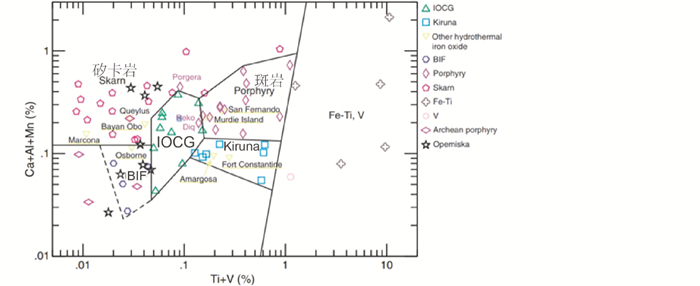
|
图 4 磁铁矿成因判别图解(据Dupuis and Beaudoin, 2011) Fig. 4 Discrimination diagram for the genesis of magnetite (after Dupuis and Beaudoin, 2011) |
与黄铁矿类似,磁铁矿的内部结构非常复杂,对其数据的分析处理非常重要。中国学者在对大冶地区程潮、铁山铁矿的磁铁矿研究中发现(Hu et al., 2014, 2015; Duan and Hu, 2014; 胡浩等, 2014),在原生热液磁铁矿基础上,由于后期热液作用等常发生溶解和重新沉淀(Dissolution-Re-precipitation)形成次生磁铁矿,而两期磁铁矿的微量元素成分相差较大。此类研究表明,对于磁铁矿高精度微量元素化学成分的研究(特别是LA-ICPMS测试)必须结合精细的矿物生成组合、期次和结构分析,否则得到的信息有可能是混杂而无意义的。Makvandi et al. (2016)和Zhao et al. (2017)的研究成果就是一个极好的例子,前者在详细的显微镜和扫描电镜工作的基础上,首先对磁铁矿的结构和表面特征进行了详细研究,划分了磁铁矿详细的世代关系,后再开展详细的元素地球化学分析工作,并对结果进行了主要成分分析(PCA),其结果表明Si、Ca、Zr、Al、Ga、Mn、Mg、Ti、Zn、Co、Ni和Cr可以用来区分VHMS矿床和基岩中的磁铁矿,并且不同基岩单元中的同类磁铁矿具有相似的化学成分特征,比如岩浆型磁铁矿具有高Ti的特征,热液型磁铁矿具有高Si、Ca和Mg的特征。变质作用形成的磁铁矿化学成分变化较大,对于目前与化学成分分析相配合的磁铁矿物理结构特征研究工作才刚刚引起重视。磁铁矿中微量元素的分析方法也存在一定的挑战,因为磁铁矿中可能存在大量的固溶体,在使用较大的激光剥蚀斑束情况下将极大的影响分析结果。如果使用相对较小的激光剥蚀斑束则会影响到含量较低的微量元素的分析,实验分析数据的质量控制对于磁铁矿的应用前景至关重要。
3 通过矿物原位微量元素组成进行区域尺度的成矿潜力预测正如前文所述,目前找矿勘查工作的目标主要为深部隐伏矿床。关于如何在一个空白勘查区初步判定深部或者已知矿床周边是否存在隐伏矿床,近年来取得了一些重要的研究进展。比如可以通过岩浆岩的部分化学成分特征,如Sr/Y比值等(Richards, 2011a, b, 2015; Loucks, 2014),通过岩浆结晶的矿物如锆石、斜长石等的主量和微量元素组成来预测岩体和区域的成矿潜力(Shen et al., 2015; Williamson et al., 2016)。尽管研究者进行过大量利用岩浆岩全岩化学组成讨论岩浆岩的成矿专属性,如Loucks (2014)通过对135个矿床的成矿岩体进行总结发现,当SiO2的值介于58%~70%之间,Sr/Y比值大于35,V/Sc比值大于10,是显生宙板块会聚边缘形成岩浆-热液铜矿床的源岛弧母岩浆的重要特征,但由于全岩分析样品的蚀变程度控制不均,其数据质量往往也不易把握,应用全岩化学组成进行区域成矿预测或成矿潜力评价的效果十分有限。与全岩分析数据相比,岩浆结晶矿物的元素组成则有潜力成为我们了解岩浆岩属性的更直接的媒介。理想的用于找矿勘探指示的矿物应该具备如下几个特征:(1)广泛的存在于矿床的围岩或者矿床内部;(2)化学组成能够灵敏的反应结晶环境;(3)能够一定程度的抵御物理和化学风化;(4)能够简单的从其围岩中分离出来。根据上述特征,锆石和磷灰石等就是其中非常合适的矿物。
3.1 锆石利用锆石微量元素组成来反演岩浆的氧化还原性质以及进一步预测岩浆岩成矿潜力和判断矿化规模的大小是近几年来的研究热点。锆石原位成分中,Ce正异常和Eu的负异常对判断岩浆氧化性非常有效(Ballard et al., 2002; Dilles et al., 2015)。Shen et al. (2015)对中亚造山带中古生代斑岩铜(金)矿床进行研究发现,岩浆的氧化态可以通过岩浆锆石中Ce4+/Ce3+的比值来进行测定。与此同时还发现,中型到大型的矿床Ce4+/Ce3+比值均大于120,而小型或者澳大利亚Lachlan褶皱带中贫矿的古生代花岗岩中锆石(Belousova et al., 2006)Ce4+/Ce3+显著较低(图 5)。这一成果是否对其它的斑岩地区也实用,是否受到特定的区域限制仍然有待于进一步的检验。Lu et al. (2016)对全球范围内的斑岩-高硫型浅成低温Cu-Au矿床(印度尼西亚的BatuHijau、菲律宾的Tampakan)、斑岩Cu-Mo-Au矿床(伊朗的Sar Cheshmeh、中国的德兴和甲马)、斑岩Cu-Mo矿床(伊朗的Sungun、中国的驱龙)和斑岩Mo矿床(中国的南泥湖和鱼池岭)中的成矿岩浆岩和一系列非矿化的S型和I型岩浆岩中的锆石进行了详细的微量元素研究,结果表明锆石中的Eu/Eu*和(Eu/Eu*)/Y的比值可以用于区分成矿和非成矿的岩体(图 6)。将锆石的微量元素与全岩化探数据相结合很可能成为矿业界用来识别未知区是否存在成矿潜力的重要方法和方向,但目前还需要大量数据的积累。
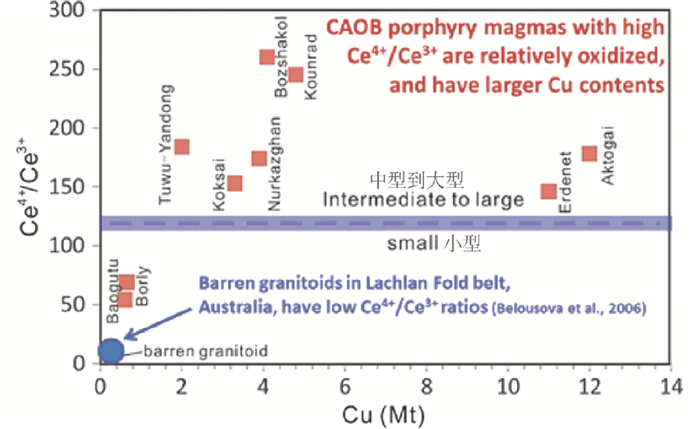
|
图 5 中亚造山带代表性斑岩铜矿床中矿化侵入体中锆石Ce4+/Ce3+比值与对应矿床的铜的吨位变化关系图(据Shen et al., 2015) 红色的小方块代表每一件锆石样品的平均比值范围 Fig. 5 Ce4+/Ce3+ ratios for zircon grains from mineralized intrusive complexes versus Cu tonnage (reserves plus past production) of the related porphyry Cu deposits from the Central Asian Orogenic Belt (CAOB) (modified after Shen et al., 2015) The red boxes represent average ratios of zircon from each rock sample |

|
图 6 锆石Eu/Eu*-(Ce/Nd)/Y相关关系图(据Lu et al., 2016) 显示成矿岩体锆石的Eu/Eu*值和(Ce/Nd)/Y值均比非成矿岩体锆石高 Fig. 6 Zircon Eu/Eu* vs. (Ce/Nd)/Y plot (after Lu et al., 2016) Fertile suites have distinctly higher zircon Eu/Eu* values ( > 0.3) and (Ce/Nd)/Y ratios ( > 0.01) than infertile magmatic suites |
岩浆斜长石在斑岩相关的侵入体中以斑晶或基质矿物的形式大量存在(Seedorff et al., 2005),具有作为斑岩矿床指示矿物的潜力。Williamson et al. (2016)注意到世界上超大型斑岩铜钼矿床Rio Blanco-Los Bronces中的岩浆斜长石比加勒比地区的与斑岩铜矿床无关的弧岩浆中的斜长石含有过剩的Al(图 7)。这种过剩的Al被解释成与岩浆富含水相关。成矿的岩浆富水是形成斑岩矿床的重要前提条件(Loucks, 2014),岩浆富水可能是由于富水的流体的注入或者富水的融体注入到母岩浆房而导致(Williamson et al., 2016)。与锆石微量元素相似,斜长石的成分组成有可能帮助我们在进行未知区域勘探的时候来进行前景评价。但是,在应用之前有两方面需要特别注意:(1)斜长石必须保存了原始岩浆的组成,即不能具有轻微的蚀变或者风化;(2)对分析方法的精度要求较高,因为成矿与非成矿的岩浆斜长石成分的差别很细微,实验误差直接影响检测结果。斑岩型矿床成矿岩浆结晶的斜长石通常会被后期的热液作用所交代,在钾化蚀变带中被正长石所交代,在青磐岩化是边带中被钠长石、绿帘石和方解石所交代,在高级泥化带中被明矾石、叶腊石、地开石和高岭石所交代。因此,在斑岩矿床的中心带很难发现保存完好且未被交代的岩浆斜长石,这种容易被交代的特征限制了斜长石被广泛应用于找矿勘探的潜力。
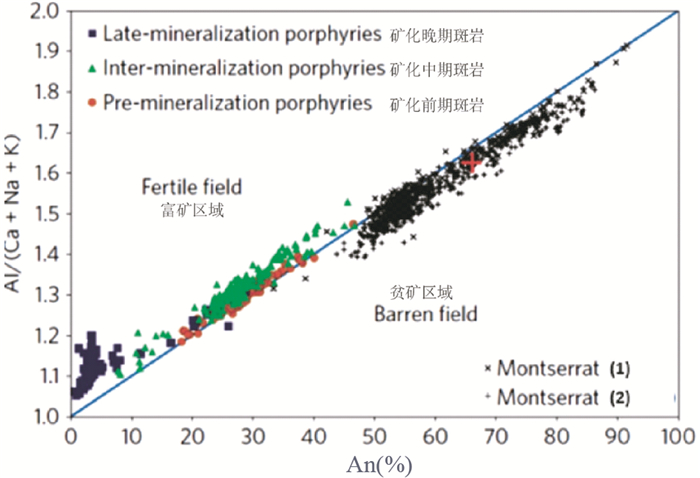
|
图 7 来自智利Rio Blanco-Los Bronces-Los Sulfatos地区La Paloma and Los Sulfatos矿带中成矿前、成矿中和成矿后斑岩体中岩浆斜长石的元素组成与Caribbean Monserrat volcano地区贫矿岩石中斜长石元素组成对比图(据Williamson et al., 2016) Fig. 7 Magmatic plagioclase compositions from pre-, inter-and late-mineralization porphyry intrusions from La Paloma and Los Sulfatos ore zones, Rio Blanco-Los Bronces-Los Sulfatos district Chile, also shown for comparative purposes are plagioclase compositions from the barren Monserrat volcano, Caribbean (modified after Williamson et al., 2016) |
磷灰石可以形成于不同的地质环境中,例如岩浆环境和热液环境(Belousova et al., 2002; Bissig and Cooke, 2014; Hughes and Rakovan, 2015; Webster and Picoli, 2015)。Mao et al. (2016)研究结果表明,判别性分析可以用来区分岩浆磷灰石和其他不同热液环境形成的磷灰石,并可以进一步区分出斑岩、矽卡岩、浅成低温、Kiruna型、IOCG(铁氧化物铜金)型和造山型矿床中的磷灰石。磷灰石的化学成分可以用来区分不同类型的斑岩矿床(如,斑岩铜,钼,金矿床和碱性斑岩型铜金矿床),不同类型的矽卡岩矿床(如矽卡岩型钨矿、金-钴、铜和铅锌等)。Bouzari et al. (2016)通过对British Columbia地区的斑岩矿床研究结果表明,磷灰石的化学成分和阴极发光结果均可以用来区分岩浆成因的磷灰石和不同的热液蚀变环境中形成的磷灰石(图 8)。
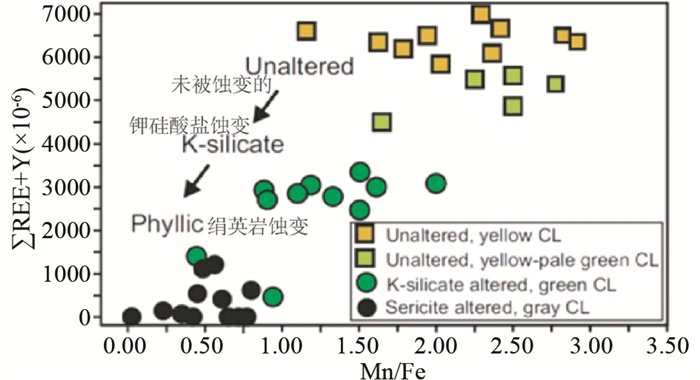
|
图 8 British Columbia地区钙碱性和碱性斑岩Cu-Au矿床中岩浆成因磷灰石和热液成因磷灰石阴极发光特征与其Mn/Fe比值和REE含量的相关变化图解(据Bouzari et al., 2016) Fig. 8 Correlation of apatite luminescence characteristics with the Mn/Fe ratio and abundances of REE in magmatic and hydrothermal apatites from calc-alkaline and alkalic porphyry Cu-Au deposits in British Columbia (after Bouzari et al., 2016) |
Bouzari et al. (2016)通过对British Columbia地区斑岩矿床中磷灰石的研究指出,被蚀变和未被蚀变的磷灰石在可见光和扫面电镜下没有显著的差别,但在阴极发光图像中存在明显的区别,而且不同类型磷灰石的阴极发光特征与部分微量元素含量存在明显的相关关系,未蚀变的磷灰石的阴极发光图像呈黄色,Mn含量较高(0.3%~0.5% MnO),Mn/Fe比值>1,而具有棕色阴极发光特征的磷灰石Mn含量较低,而S、REE+Y的含量较高。与钾硅酸盐蚀变相关的磷灰石具有绿色的阴极发光特征,这类磷灰石Mn/Fe比值较低,其它一些微量元素如Cl、S和Na的亏损。与白云母蚀变相关的磷灰石具有灰色的阴极发光特征,这主要是由于在钙碱性斑岩矿床的酸性绢英岩化蚀变阶段,磷灰石中Mn的大量丢失(<0.15%),同时伴有Na、S、Cl和REE的亏损。目前只有少部分研究报道不同类型矿床中磷灰石的特征微量元素组成。Cao et al. (2012)和Bouzari et al. (2011)分别对斑岩铜(钼)矿床中的岩浆和热液磷灰石开展了研究,结果表明磷灰石的微量元素组成可以用作这类矿床的勘探指示。Mao et al. (2016)通过600多个电子探针和LA-ICPMS磷灰石微量元素数据认为:(1)Mg、V、Mn、Sr、Y、La、Ce、Eu、Dy、Yb、Pb、Th和U可以有效区分矿床中的磷灰石和碳酸盐岩以及非矿化岩石中的磷灰石,矿床中的磷灰石钙含量更高;(2)不同类型矿床中的磷灰石具有明显不同的微量元素组成:世界范围内的碳酸盐岩中的磷灰石具有最为分异的REE分配特征,LREE富集((Ce/Yb)N=35~872)、高V(1.6×10-6~1466×10-6)、Sr(1840×10-6~22498×10-6)、Ba(1.8×10-6~275×10-6)和Nb(0.4×10-6~19×10-6)含量,低W(0.05×10-6~0.55×10-6),没有明显的Eu异常(Eu/Eu*=0.9~1.2)。北美碱性斑岩铜金矿床中的磷灰石具有很高的V(2.5×10-6~337×10-6),然而钙碱性斑岩铜金和斑岩铜钼矿床中的磷灰石含有较高的Mn(334×10-6~10934×10-6)和显著的负的Eu异常(Eu/Eu*=0.2~1.1)。位于加拿大、中国和墨西哥等地的IOCG矿床、Kiruna型铁氧化物-磷灰石矿床中的磷灰石具有很强的Eu负异常(Eu/Eu*=0.2~1.5)和较低的Mn含量(40×10-6~5753×10-6)。造山型镍铜矿床、斑岩相关的富铜金的角砾岩、矽卡岩金钴矿床、矽卡岩铅锌和矽卡岩铜矿床中的磷灰石具有相对较低的杂质阳离子。这一研究为我们提供了一种通过磷灰石微量元素成分来判别覆盖区所隐藏的矿床类型的有效一种方法。
需要注意的是,上述这些矿物原位成分得到的地球化学指标仅仅是对成矿潜力进行预测,并不能证实矿体的真实存在,不能更进一步告诉我们矿化的具体位置,但是这些方法可以让我们排除那些成矿潜力低的岩浆岩,从而专注于更具潜力的靶区。接下来,我们需要更为直接的方法和手段来帮助我们预测浅表以下的隐伏矿体是否真实存在。
4 应用矿物原位微量元素进行勘探区内的靶区圈定在岩浆热液矿床的形成过程中,从热液流体中沉淀出来的金属元素赋存于侵入体的内部或在侵入体周围的围岩中。围绕着矿床中心通常存在一个巨大的蚀变晕,在这个蚀变晕中,矿物组成和化学成分组成上都可能显示出一定的分带性(Lowell and Guilbert, 1970)。这一蚀变分带特征也是矿床勘查的重要指标,相关特征在进行斑岩矿床的勘查中体现得尤为重要。蚀变带给我们提供了在区域尺度上寻找斑岩矿床靶区(蚀变范围宽达10km)(Cooke et al., 2014a, b),但是真正的具有经济价值的矿化中心往往就在几百米到1km的范围内,而且相同的矿物组合形成的蚀变带也可以出现在贫矿的热液系统中,或者出现在区域变质作用系统中。因此,有效的区分成矿和非成矿的系统,在蚀变带中定位热液活动的中心,以及蚀变成矿系统的边界,是找矿勘探工作所面临的重要任务和巨大挑战,基于绿泥石、绿帘石、明矾石等矿物LA-ICPMS原位测定得到的微量元素成分研究已经显现出成功的曙光。
4.1 绿泥石绿泥石是一种非常普遍的蚀变矿物,广泛存在于不同类型的矿床中。其中,绿泥石在斑岩型矿床的青磐岩化蚀变带分布最为广泛。Wilkinson et al. (2015)对印度尼西亚BatuHijau超大型斑岩铜金矿床青磐岩化蚀变带中的绿泥石开展了详细的电子探针和LA-ICPMS原位成分分析及相关研究,结果显示,一系列元素如K、Li、Mg、Ca、Sr、Ba、Ti、V、Mn、Co、Ni、Zn和Pb等,有可能进入到绿泥石的晶格中,而且随着距离斑岩体侵入中心的远近出现系统的空间变化。比如Ti、V和Mg的含量随着距离斑岩体侵入中心的距离增加而呈指数级降低,也有一部分元素如Sr、Ca、Mn、Zn等则呈现相反的规律。因而青磐岩化蚀变带中绿泥石的化学成分的系统变化可以用作预测矿化侵入体的方向以及距离侵入体中心的距离。
Wilkinson et al. (2015)的研究还指出绿泥石中的Ti的取代程度是受矿物的结晶温度控制的,因而绿泥石中的Ti的含量的空间变化也是矿化中心周围的热异常的反应。相反,Mn和Zn在绿泥石中的含量随着距离斑岩体中心的距离增大而逐渐升高,在大约1.3km左右的位置出现最大值,然后再逐渐降低,这一特征反映了Mn、Zn这些金属元素随岩浆热液流体在围岩中水平移动的距离。通过绿泥石识别出的斑岩矿床的异常晕可以延伸到至少4.5km以外,远远超过全岩化探异常所能探测距离(≤1.5km),由此说明绿泥石的化学成分将是斑岩系统环境中一种新型、有效的找矿勘探方法。绿泥石的化学成分在青磐岩化蚀变内带(大约<2.5km)出现的系统性变化,给我们在特定的蚀变带内提供了一种精确的找矿勘探指针。在斑岩矿床的青磐岩化蚀变带中,绿泥石中的Ti/Sr比值和样品距离矿化中心的位置关系可以拟合出下述方程(图 9):

|
图 9 绿泥石中Ti/Sr比值与对应样品到BatuHijau矿床中心的距离关系图(据Wilkinson et al., 2015) 灰色区域显示全岩地化数据给出的Ti/Sr比值变化范围;不同颜色的小圈代表不同采样剖面的样品 Fig. 9 Plot of Ti/Sr ratio in chlorite as a function of radial distance from the Batu Hijau centre (after Wilkinson et al., 2015) Gray shaded field shows whole rock ratio data for comparison. Different trends as a function of traverse direction |
x代表距离侵入中心的距离;R代表绿泥石中Ti/Sr元素的比值;a和b代表指数拟合参数。这一成果在国际勘探领域得到了多次的应用和验证,正在成为一种普遍的勘探辅助手段。更为重要的是,与斑岩矿床相关的远矿绿泥石的化学成分与区域变质作用形成的绿泥石成分存在显著的差异,这个信息可以让我们有效识别斑岩相关的热液系统的边界,并将其区别于区域背景的变质成因。
4.2 绿帘石绿帘石跟绿泥石一样,是很多类型矿床中普遍存在的蚀变矿物,是斑岩系统中青磐岩化蚀变带中的特征矿物之一,分布非常广泛。绿帘石通常以交代含钙的矿物(如斜长石、角闪石)形式,或以脉体的形式存在。在斑岩矿床中,绿帘石脉主要产于石英网脉带的外侧,因而绿帘石脉的空间分布便可以用来指示斑岩系统的中心。Cooke et al.(2014a, b)对菲律宾Baguio地区的斑岩铜金矿床中绿帘石进行详细研究,结果显示绿帘石的微量元素组成随着样品距离斑岩矿床矿化中心距离的变化而变化(图 10)。绿帘石中的As、Sb和Pb这些远端指示元素会在距离矿化中心几千米远的样品中富集。与此同时,这些元素在富矿的斑岩系统绿帘石中的含量比贫矿的斑岩系统明显高。这些结果表明,绿帘石具有极大的潜力成为指示斑岩矿床中心以及判别系统成矿潜力的重要矿物。Wilkinson et al. (2017)对智利El Teniente斑岩铜钼矿床的绿帘石进行了相关研究,其结果与Baguio地区类似。绿帘石的微量元素组成还能用来判别矿物是热液成因(斑岩相关)还是变质成因,Baker et al. (2017)指出绿帘石中的Sr/As和Pb/U比值可以有效地将智利中部地区变质成因的绿帘石从同一地区的斑岩相关的热液成因绿帘石中区分出来,这些变质成因的绿帘石通常含有非常低的Sb和As等远端指示元素。
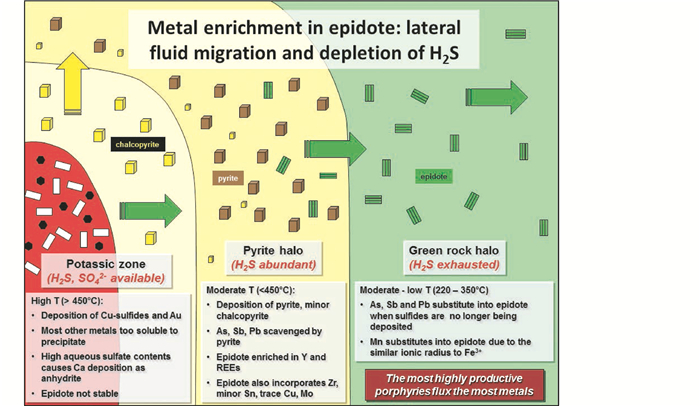
|
图 10 绿帘石中微量元素的含量随距离斑岩矿床中心的远近的变化关系示意图(据Cooke et al., 2014a, b) Fig. 10 Schematic model explaining trace element enrichment in epidote as a function of lateral distance from the porphyry deposit centre (after Cooke et al., 2014a, b) |
在斑岩矿床的顶部往往存在一个大面积的酸性蚀变岩帽,明矾石是该酸性蚀变岩帽中的标志性矿物之一。所谓的酸性蚀变岩帽指的是深成岩浆作用产生的气液在浅部岩石中形成的水平或近水平面状分布的硅化(多孔状石英和块状石英)和高级泥化蚀变带(Sillitoe, 1995),是斑岩-浅成低温热液系统在浅部环境的体现。由于这一套蚀变的分布范围巨大,而且蚀变带中的蚀变矿物多为较难被肉眼直接识别的粘土矿物组成,因为给找矿勘探工作带来了极大的难度。近年来,在矿产勘查领域逐渐广泛应用的短波红外光谱(short wavelength infra-red, SWIR)技术(Hauff and Cocks, 1992; Yang et al., 1998, 2000, 2001, 2004, 2005; Arne et al., 1999; Thompson et al., 2009; Chang et al., 2011),以其独特的技术优势,可以快速鉴定热液蚀变过程中常见的含羟基矿物及硫酸盐矿物,进行蚀变矿物填图,还可以利用一些矿物反射光谱特征(如明矾石的特征吸收峰1480nm)的系统变化,直接定位热液/矿化中心。如Chang et al. (2011)在研究菲律宾Mankayan地区Lepanto高硫浅成低温热液矿床的蚀变岩帽时发现,蚀变矿物明矾石1480nm吸收峰位相对于侵入体位置有系统性的变化规律:靠近侵入体中心部位,明矾石1480nm吸收峰位较高(可达1498nm),远离侵入体中心,明矾石1480nm吸收峰位较低(可低至1475nm)(图 11)。详细研究之后发现,明矾石1480nm吸收峰位与明矾石中的Na/(Na+K)比值密切相关(正相关),而Na/(Na+K)比值又受到矿物形成时温度的控制,较高温度下形成的明矾石具有较高的Na/(Na+K)比值,表明明矾石1480nm吸收峰位与矿物的形成温度密切相关,从而可以通过明矾石1480nm吸收峰位的系统变化和原位微量元素成分特征来定位侵入体中心及斑岩型矿化的位置。
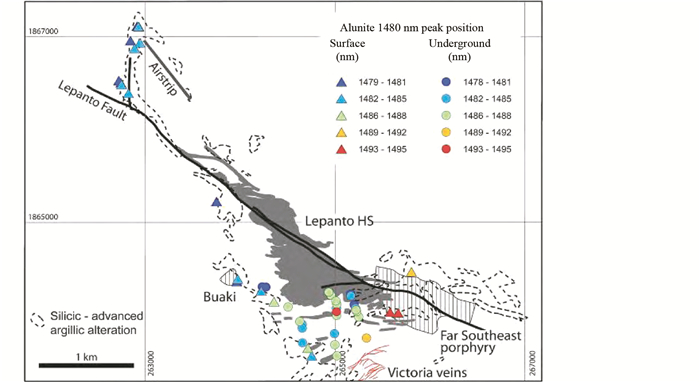
|
图 11 菲律宾Mankayan地区明矾石1480nm吸收峰与侵入体中心距离关系图(据Chang et al., 2011) 深灰色充填区代表Lepanto高硫型矿床,垂直条纹填充区代表Far Southeast斑岩矿床,虚线部分代表酸性蚀变岩冒出露区.明矾石的SWIR数据显示高的吸收峰值样品更靠近Far Southeast斑岩矿床 Fig. 11 Alunite absorption feature at ~1, 480nm shifts to higher SWIR wavelength position toward intrusive center in Mankayan district, Philippines (after Chang et al., 2011) The location of the Lepanto enargite deposit and Far Southeast porphyry Cu-Au deposit is shown in grey fill and vertical striped fill, respectively, with surface outcrops of the lithocap marked by dashed lines. Alunite SWIR results showing higher wavelength samples closer to Far Southeast porphyry |
Chang et al. (2011)对菲律宾Mankayan地区的系统研究还表明,明矾石的微量元素组成随着样品距离远东南(Far Southeast)矿床斑岩成矿系统中心的距离变化而系统的变化。例如,在距离远东南斑岩较近的明矾石较距离较远的明矾石样品含有较高的Sr和La的含量,反之,明矾石中的Pb(取代钾进入到明矾石的晶格中)含量在距离远东南斑岩较远的样品中含量较距离远东南较近的样品高(图 12)。因此,明矾石的部分微量元素的含量变化给我们在酸性蚀变岩帽中的找矿勘探提供了一种精确的勘探指针。

|
图 12 菲律宾Mankayan地区明矾石中Pb的含量与侵入体中心距离关系图(据Chang et al., 2011) 明矾石的LA-ICPMS微量元素数据显示,明矾石中Pb的含量随着距离Far Southeast斑岩矿床的距离增大而增大 Fig. 12 Alunite Pb content decreases toward intrusive center in Mankayan district, Philippines (after Chang et al., 2011) Alunite LA-ICPMS data showing Pb content in alunite increasing with the distance from Far Southeast porphyry |
随着微区分析技术的飞速发展,矿物原位微量元素组成的研究已成为地球科学领域特别是矿床学和勘查学的研究热点。大量研究成果表明,矿物原位微量元素的组成可以用于判断元素在矿物中的赋存状态,可以用于约束岩石的形成时代和形成环境,可以约束微量元素在地质事件不同阶段的活化迁移行为,从而能够反演成矿流体的演化,并示踪成矿物质的来源,约束其成因。在国际矿床学和找矿勘查领域,矿物原位微量元素研究已经被广泛和成功地应用于找矿预测和深部勘查实践中。已有的研究成果显示,可以通过岩浆结晶矿物中某些微量元素的灵敏变化来帮助我们识别具有成矿潜力的成矿带,而且可以进一步通过蚀变矿物中微量元素的组成变化来指示矿化中心的方向和位置,估算距离矿化中心的距离。但是,部分矿物的分析方法还有待于进一步开发和完善,矿物微量元素组成的结果还有待于结合地质背景和样品特征进行深入的解释,如黄铁矿和磁铁矿具有复杂的内部结构,有的矿床中的黄铁矿具有多期生长历史,要得到准确的数据解译结果,对其内部结构和复杂的形成过程的细致和准确分析就显得尤为重要。除此之外,实验标样的稀缺(如硫化物),不同实验室的矿物原位LA-ICPMS微量元素分析方法和标准不一致,导致的数据质量的差异也是限制部分方法被广泛应用的因素之一。矿物微量元素组成的研究还有着广阔的发展空间,是未来隐伏矿产勘查的主要手段之一。一大批岩浆矿物(如云母、角闪石和榍石等)和热液蚀变矿物(如绢云母、伊利石、萤石和石膏等)的微量元素组成在岩石、矿床成因和找矿预测方面的研究还有待于我们深入的探索。
中国是资源需求大国,矿产资源是我国的重要战略资源,深部隐伏矿床寻找与勘查是当前和今后我们面临的主要方向和任务。在这种资源勘查的新形势下,找矿勘查新方法探索和新技术应用及相关基础研究亟待加强,这为进行矿物原位LA-ICPMS微量元素分析,应用矿物微量元素组成来指导深部矿床勘查等提供了巨大的发展机遇,也有望成为未来矿床学和勘查学领域的重点研究方向。
Abraitis PK, Pattrick RAD and Vaughan DJ. 2004. Variations in the compositional, textural and electrical properties of natural pyrite:A review. International Journal of Mineral Processing, 74(1-4): 41-59. DOI:10.1016/j.minpro.2003.09.002 |
Agangi A, Hofmann A and Wohlgemuth-Ueberwasser CC. 2013. Pyrite zoning as a record of mineralization in the ventersdorp contact reef, Witwatersrand basin, South Africa. Economic Geology, 108(6): 1243-1272. DOI:10.2113/econgeo.108.6.1243 |
Agangi A, Hofmann A, Rollion-Bard C, Marin-Carbonne J, Cavalazzi B, Large R and Meffre S. 2015. Gold accumulation in the Archaean Witwatersrand Basin, South Africa:Evidence from concentrically laminated pyrite. Earth-Science Reviews, 140: 27-53. DOI:10.1016/j.earscirev.2014.10.009 |
Arne DC, Bierlein FO, McKnight S and Mernagh T. 1999. Recognition of wallrock alteration in sediment hosted mesothermal gold deposits:Examples from central Victoria. Australian Institute of Geoscientists Bulletin, 30: 89-96. |
Audétat A, Günther D and Heinrich CA. 1998. Formation of a magmatic-hydrothermal ore deposit:Insights with LA-ICP-MS analysis of fluid inclusions. Science, 279(5359): 2091-2094. DOI:10.1126/science.279.5359.2091 |
Baker M, Cooke DR, Hollings P and Piquer J. 2017. Identification of hydrothermal alteration related to mineralisation using epidote mineral chemistry. In:Mineral Resources to Discover:Society of Geology Applied to Ore Deposits. Quebec:14th Biennial Conference Proceedings
|
Ballard JR, Palin JM and Campbell IH. 2002. Relative oxidation states of magmas inferred from Ce(Ⅳ)/Ce(Ⅲ) in zircon:Application to porphyry copper deposits of northern Chile. Contributions to Mineralogy and Petrology, 144(3): 347-364. DOI:10.1007/s00410-002-0402-5 |
Belousova EA, Walters S, Griffin WL and O'Reilly SY. 2001. Trace-element signatures of apatite in granitoids from the Mt Isa inlier, northwestern Queensland. Australian Journal of Earth Sciences, 48(4): 603-619. DOI:10.1046/j.1440-0952.2001.00879.x |
Belousova EA, Griffin WL, O'Reilly SY and Fisher NI. 2002. Apatite as an indicator mineral for mineral exploration:Trace-element compositions and their relationship to host rock type. Journal of Geochemical Exploration, 76(1): 45-69. DOI:10.1016/S0375-6742(02)00204-2 |
Belousova EA, Griffin WL and O'Reilly SY. 2006. Zircon crystal morphology, trace element signatures and Hf isotope composition as a tool for petrogenetic modelling:Examples from Eastern Australian granitoids. Journal of Petrology, 47(2): 329-353. DOI:10.1093/petrology/egi077 |
Bissig T and Cooke DR. 2014. Introduction to the special issue devoted to alkalic porphyry Cu-Au and epithermal Au deposits. Economic Geology, 109(4): 819-825. DOI:10.2113/econgeo.109.4.819 |
Bouzari F, Hart CJR, Barker S and Bissig T. 2011. Exploration for concealed deposits using porphyry indicator minerals (PIMs):Application of apatite texture and chemistry. In:25th International Applied Geochemistry Symposium. Rovaniemi, Finland, 89-90
|
Bouzari F, Hart CJR, Bissig T and Barker S. 2016. Hydrothermal alteration revealed by apatite luminescence and chemistry:A potential indicator mineral for exploring covered porphyry copper deposits. Economic Geology, 111(6): 1397-1410. DOI:10.2113/econgeo.111.6.1397 |
Burnham AD and Berry AJ. 2012. An experimental study of trace element partitioning between zircon and melt as a function of oxygen fugacity. Geochimica et Cosmochimica Acta, 95: 196-212. DOI:10.1016/j.gca.2012.07.034 |
Cao MJ, Li GM, Qin KZ, Seitmuratova EY and Liu YS. 2012. Major and trace element characteristics of apatiteS in granitoids from central Kazakhstan:Implications for petrogenesis and mineralization. Resource Geology, 62(1): 63-83. DOI:10.1111/rge.2012.62.issue-1 |
Castro W, Hoogewerff J, Latkoczy C and Almirall JR. 2010. Application of laser ablation (LA-ICP-SF-MS) for the elemental analysis of bone and teeth samples for discrimination purposes. Forensic Science International, 195(1-3): 17-27. DOI:10.1016/j.forsciint.2009.10.029 |
Chang Z, Hedenquist JW, White NC, Cooke DR, Roach M, Deyell CL, Garcia J, Gemmell JB, McKnight S and Cuison AL. 2011. Exploration tools for linked porphyry and epithermal deposits:Example from the Mankayan intrusion-centered Cu-Au district, Luzon, Philippines. Economic Geology, 106(8): 1365-1398. DOI:10.2113/econgeo.106.8.1365 |
Chen BH, Wang ZL, Li HL, Li JK, Li JL and Wang GQ. 2014. Evolution of ore fluid of the Taishang gold deposit, Jiaodong:Constraints on REE and trace element component of auriferous pyrite. Acta Petrologica Sinica, 30(9): 2518-2532. |
Chen HY and Han JS. 2015. Study of magnetite:Problems and future. Bulletin of Mineralogy, Petrology and Geochemistry, 34(4): 724-730. |
Chen L, Li XH, Li JW, Hofstra AH, Liu Y and Koenig AE. 2015. Extreme variation of sulfur isotopic compositions in pyrite from the Qiuling sediment-hosted gold deposit, West Qinling orogen, Central China:An in situ SIMS study with implications for the source of sulfur. Mineralium Deposita, 50(6): 643-656. DOI:10.1007/s00126-015-0597-9 |
Chiaradia M, Schaltegger U, Spikings R, Wotzlaw JF and Ovtcharova M. 2013. How accurately can we date the duration of magmatic-hydrothermal events in porphyry systems? An invited paper. Economic Geology, 108(4): 565-584. DOI:10.2113/econgeo.108.4.565 |
Claiborne LL, Miller CF, Walker BA, Wooden JL, Mazdab FK and Bea F. 2006. Tracking magmatic processes through Zr/Hf ratios in rocks and Hf and Ti zoning in zircons:An example from the Spirit Mountain batholith, Nevada. Mineralogical Magazine, 70(5): 517-543. DOI:10.1180/0026461067050348 |
Cook NJ, Ciobanu CL and Mao JW. 2009. Textural control on gold distribution in As-free pyrite from the Dongping, Huangtuliang and Hougou gold deposits, North China Craton (Hebei Province, China). Chemical Geology, 264(1-4): 101-121. DOI:10.1016/j.chemgeo.2009.02.020 |
Cook NJ, Ciobanu CL, Danyushevsky LV and Gilbert S. 2011. Minor and trace elements in bornite and associated Cu-(Fe)-sulfides:A LA-ICP-MS study bornite mineral chemistry. Geochimica et Cosmochimica Acta, 75(21): 6473-6496. DOI:10.1016/j.gca.2011.08.021 |
Cook NJ, Ciobanu CL, Meria D, Silcock D and Wade B. 2013. Arsenopyrite-pyrite association in an orogenic gold ore:Tracing mineralization history from textures and trace elements. Economic Geology, 108(6): 1273-1283. DOI:10.2113/econgeo.108.6.1273 |
Cooke DR, Baker M, Hollings P, Sweet G, Chang Z, Danyushevsky L, Gilbert S, Zhou TF, White NC, Gemmell JB and Inglis S. 2014a. New advances in detecting the distal geochemical footprints of porphyry systems-epidote mineral chemistry as a tool for vectoring and fertility assessments. In:Kelley KD and Golden HC (eds.). Building Exploration Capability for the 21st Century. SEG Special Publication, 18. Boulder, CO, USA:Society of Economic Geologists, 127-152
|
Cooke DR, Hollings P, Wilkinson JJ and Tosdal RM. 2014b. Geochemistry of porphyry deposits. In:Holland HD and Turekian KK (eds.). Treatise on Geochemistry. 2nd Edition. Oxford:Elsevier, 357-381
|
Cooke DR, Wilkinson JJ, Baker M, Agnew P, Wilkinson CC, Martin H, Chang ZS, Chen HY, Gemmell JB, Inglis S, Danyushevsky L, Gilbert S and Hollings P. 2015. Using mineral chemistry to detect the location of concealed porphyry deposits:An example from Resolution, Arizona. In:27th International Association of Geochemistry Symposium. Tucson, Arizona
|
Cooke DR, White NC, Zhang L, Chang Z and Chen H. 2017. Lithocaps-characteristics, origins and significance for porphyry and epithermal exploration. In:Mineral Resources to Discover:Society of Geology Applied to Ore Deposits. Quebec:14th Biennial Conference Proceedings
|
Craig JR, Vokes FM and Solberg TN. 1998. Pyrite:Physical and chemical textures. Mineralium Deposita, 34(1): 82-101. DOI:10.1007/s001260050187 |
Cross AJ. 2000. An investigation of the minor and trace element chemistry of hydrothermal porphyry and skarn-related magnetite. Ph. D. Dissertation. Canberra:University of Canberra, 1-171
|
Daliran F, Stosch HG, Williams PJ, Jamali H and Dorri MB. 2010. Early Cambrian iron oxide-apatite-REE (U) deposits of the Bafq District, east-central Iran. In:Corriveau L and Mumin H (eds.). Exploring for Iron Oxide Copper-Gold Deposits:Canada and Global Analogues. Canada:Geological Association of Canada, 147-160
|
Dare SAS, Barnes SJ, Beaudoin G, Méric J, Boutroy E and Potvin-Doucet C. 2014. Trace elements in magnetite as petrogenetic indicators. Mineralium Deposita, 49(7): 785-796. DOI:10.1007/s00126-014-0529-0 |
De Brodtkorb MK. 2009. Precious metal tellurides and other Te-bearing minerals in different paragenesis of Argentina:A review. Revista de la Asociación Geológica Argentina, 64(3): 365-372. |
Deditius AP, Utsunomiya S, Ewing RC, Chryssoulis SL, Venter D and Kesler SE. 2009. Decoupled geochemical behavior of As and Cu in hydrothermal systems. Geology, 37(8): 707-710. DOI:10.1130/G25781A.1 |
Deditius AP, Reich M, Kesler SE, Utsunomiya S, Chryssoulis SL, Walshe J and Ewing RC. 2014. The coupled geochemistry of Au and As in pyrite from hydrothermal ore deposits. Geochimica et Cosmochimica Acta, 140: 644-670. DOI:10.1016/j.gca.2014.05.045 |
Deol S, Deb M, Large RR and Gilbert S. 2012. LA-ICPMS and EPMA studies of pyrite, arsenopyrite and loellingite from the Bhukia-Jagpura gold prospect, southern Rajasthan, India:Implications for ore genesis and gold remobilization. Chemical Geology, 326-327: 72-87. DOI:10.1016/j.chemgeo.2012.07.017 |
Dilles JH, Kent AJR, Wooden JL, Tosdal RM, Koleszar A, Lee RG and Farmer LP. 2015. Zircon compositional evidence for sulphur-degassing from ore-forming arc magmas. Economic Geology, 110(1): 241-251. DOI:10.2113/econgeo.110.1.241 |
Duan Z, Li JW and Hu H. 2014. New constraints on the genesis of the Tieshan Fe-Cu skarn deposit, SE Hubei Province, China:Textural and geochemical data of magnetite. Acta Geologica Sinica, 88(Suppl.2): 1449-1450. |
Dupuis C and Beaudoin G. 2011. Discriminant diagrams for iron oxide trace element fingerprinting of mineral deposit types. Mineralium Deposita, 46(4): 319-335. DOI:10.1007/s00126-011-0334-y |
Ferry JM and Watson EB. 2007. New thermodynamic models and revised calibrations for the Ti-in-zircon and Zr-in-rutile thermometers. Contributions to Mineralogy and Petrology, 154(4): 429-437. DOI:10.1007/s00410-007-0201-0 |
Geisler T, Schaltegger U and Tomaschek F. 2007. Re-equilibration of zircon in aqueous fluids and melts. Elements, 3(1): 43-50. DOI:10.2113/gselements.3.1.43 |
Gray AL. 1985. Solid sample introduction by laser ablation for inductively coupled plasma source mass spectrometry. Analyst, 110(5): 551-556. DOI:10.1039/an9851000551 |
Gregory DD, Large RR, Halpin JA, Lounejeva E, Wu S, Bull SW, Sack PJ, Lyons T and Chappaz A. 2015a. Accumulation of trace elements into black shale:How to identify a viable source rock for orogenic and Carlin-style gold deposits. In:Proceedings of the PACRIM 2015 Congress. Hong Kong:Australian Research Council, 59-64
|
Gregory DD, Large RR, Halpin JA, Lounejeva E, Lyons TW, Wu S, Danyushevsky L, Sack PJ, Chappaz A, Maslennikov VV and Bull SW. 2015b. Trace element content of sedimentary pyrite in black shales. Economic Geology, 110(6): 1389-1410. DOI:10.2113/econgeo.110.6.1389 |
Hansen EC and Harlov DE. 2007. Whole-rock, phosphate, and silicate compositional trends across an amphibolite-to granulite-facies transition, Tamil Nadu, India. Journal of Petrology, 48(9): 1641-1680. DOI:10.1093/petrology/egm031 |
Harlov DE, Andersson UB, Förster HJ, Nyström JO, Dulski P and Broman C. 2002. Apatite-monazite relations in the Kiirunavaara magnetite-apatite ore, northern Sweden. Chemical Geology, 191(1-3): 47-72. DOI:10.1016/S0009-2541(02)00148-1 |
Harlov DE and Förster HJ. 2003. Fluid-induced nucleation of (Y+REE)-phosphate minerals within apatite:Nature and experiment. Part Ⅱ. Fluorapatite. American Mineralogist, 88: 1209-1229. |
Harlov DE, Wirth R and Förster HJ. 2005. An experimental study of dissolution-reprecipitation in fluorapatite:Fluid infiltration and the formation of monazite. Contributions to Mineralogy and Petrology, 150(3): 268-286. DOI:10.1007/s00410-005-0017-8 |
Harlov DE. 2015. Apatite:A fingerprint for metasomatic processes. Elements, 11(3): 171-176. DOI:10.2113/gselements.11.3.171 |
Hauff P and Cocks T. 1992. Short wave infra-red spectroscopy techniques applied to exploration:Emphasis on alteration mineralogy. Contributions of Economic Geology Research Unit, 44: 72-74. |
Hoskin PWO and Schaltegger U. 2003. The composition of zircon and igneous and metamorphic petrogenesis. Reviews in Mineralogy and Geochemistry, 53(1): 27-62. DOI:10.2113/0530027 |
Hu H, Li JW, Lentz D, Ren Z, Zhao XF, Deng XD and Hall D. 2014. Dissolution-reprecipitation process of magnetite from the Chengchao iron deposit:Insights into ore genesis and implication for in-situ chemical analysis of magnetite. Ore Geology Reviews, 57: 393-405. DOI:10.1016/j.oregeorev.2013.07.008 |
Hu H, Duan Z, Luo Y and Li JW. 2014. Trace element systematics of magnetite from the Chengchao iron deposit in the Daye district:A laser ablation ICP-MS study and insights into ore genesis. Acta Petrologica Sinica, 30(5): 1292-1306. |
Hu H, Lentz D, Li JW, McCarron T, Zhao XF and Hall D. 2015. Re-equilibration processes in magnetite from iron skarn deposits. Economic Geology, 110(1): 1-8. DOI:10.2113/econgeo.110.1.1 |
Hughes JM, Cameron M and Crowley KD. 1991a. Ordering of divalent cations in the apatite structure:Crystal structure refinements of natural Mn-and Sr-bearing apatite. American Mineralogist, 76(11-12): 1857-1862. |
Hughes JM, Cameron M and Mariano AN. 1991b. Rare-earth-element ordering and structural variations in natural rare-earth-bearing apatites. American Mineralogist, 76(7): 1165-1173. |
Hughes JM and Rakovan JF. 2015. Structurally robust, chemically diverse:Apatite and apatite supergroup minerals. Elements, 11(3): 165-170. DOI:10.2113/gselements.11.3.165 |
Jonsson E, Persson Nilsson K, Högdahl K, Troll VR and Hallberg A. 2010. REE distribution and mineralogy in a Palaeoproterozoic apatite-iron oxide deposit:Grängesberg, Bergslagen, Sweden. Acta Mineralogica-Petrographica (Abstract Series), 6: 1-234. |
Kemp AIS, Hawkesworth CJ, Foster GL, Paterson BA, Woodhead JD, Hergt JM, Gray CM and Whitehouse MJ. 2007. Magmatic and crustal differentiation history of granitic rocks from Hf-O isotopes in zircon. Science, 315(5814): 980-983. DOI:10.1126/science.1136154 |
Koch J and Günther D. 2011. Review of the state-of-the-art of laser ablation inductively coupled plasma mass spectrometry. Applied Spectroscopy, 65(5): 155-162. DOI:10.1366/11-06255 |
Koglin N, Frimmel HE, Lawrie Minter WE and Brätz H. 2010. Trace-element characteristics of different pyrite types in Mesoarchaean to Palaeoproterozoic placer deposits. Mineralium Deposita, 45(3): 259-280. DOI:10.1007/s00126-009-0272-0 |
Kouzmanov K, Pettke T and Heinrich CA. 2010. Direct analysis of ore-precipitating fluids:Combined IR microscopy and LA-ICP-MS study of fluid inclusions in opaque ore minerals. Economic Geology, 105(2): 351-373. DOI:10.2113/gsecongeo.105.2.351 |
Kouzmanov K and Pokrovski GS. 2012. Hydrothermal controls on metal distribution in Cu(-Mo-Au)systems. In:Hedenquist JW, Harris M and Camus F (eds.). Geology and Genesis of Major Copper Deposits and Districts of the World:A Tribute to Richard H. Sillitoe. Society of Economic Geologists Special Publication, 16:573-618
|
Large RR, Maslennikov VV, Robert F, Danyushevsky LV and Chang Z. 2007. Multistage sedimentary and metamorphic origin of pyrite and gold in the giant Sukhoi log deposit, Lena Gold Province, Russia. Economic Geology, 102(7): 1233-1267. DOI:10.2113/gsecongeo.102.7.1233 |
Large RR, Danyushevsky LV, Hollit C, Maslennikov V, Meffre S, Gilbert S, Bull S, Scott R, Emsbo P, Thomas H, Singh B and Foster J. 2009. Gold and trace element zonation in pyrite using a laser imaging technique:Implications for the timing of gold in Orogenic and Carlin-style sediment-hosted deposits. Economic Geology, 104(5): 635-668. DOI:10.2113/gsecongeo.104.5.635 |
Large RR, Halpin JA, Danyushevsky VV, Maslennikov VV, Bull SW, Long JA, Gregory DD, Lounejeva E, Lyons TM, Sack PJ, McGoldrick PJ and Calver CR. 2014. Trace element content of sedimentary pyrite as a new proxy for deep-time ocean-atmosphere evolution. Earth and Planetary Science Letters, 389: 209-220. DOI:10.1016/j.epsl.2013.12.020 |
Large RR, Mukherjee I, Gregory DD, Steadman JA, Maslennikov VV and Meffre S. 2017. Ocean and atmosphere geochemical proxies derived from trace elements in marine pyrite:Implications for ore genesis in sedimentary basins. Economic Geology, 112(2): 423-450. DOI:10.2113/econgeo.112.2.423 |
Lin Y, Cook NJ, Ciobanu CL, Liu YP, Zhang Q, Liu TG, Gao W, Yang YL and Danyushevskiy L. 2011. Trace and minor elements in sphalerite from base metal deposits in South China:A LA-ICPMS study. Ore Geology Reviews, 39(4): 188-217. DOI:10.1016/j.oregeorev.2011.03.001 |
Liu YS, Hu ZC, Li M and Gao S. 2013. Applications of LA-ICP-MS in the elemental analyses of geological samples. Chinese Science Bulletin, 58(32): 3863-3878. DOI:10.1007/s11434-013-5901-4 |
Loucks RR. 2014. Distinctive composition of copper-ore-forming arc magmas. Australian Journal of Earth Sciences:An International Geoscience Journal of the Geological Society of Australia, 61(1): 5-16. |
Lowell JD and Guilbert JM. 1970. Lateral and vertical alteration-mineralization zoning in porphyry ore deposits. Economic Geology, 65(4): 373-408. DOI:10.2113/gsecongeo.65.4.373 |
Lu YJ, Loucks RR, Fiorentini M, McCuaig TC, Evans NJ, Yang ZM, Hou ZQ, Kirkland CL, Parra-Avila LA and Kobussen A. 2016. Zircon compositions as a pathfinder for porphyry Cu ±Mo ±Au deposits. In:Richards J (ed.). Society of Economic Geologists Special Publication No.19 on Tethyan Tectonics and Metallogeny. Littleton, CO:Society of Economic Geologists, 329-347
|
Luo Y, Hughes JM, Rakovan J and Pan YM. 2009. Site preference of U and Th in Cl, F, and Sr apatites. American Mineralogist, 94(2-3): 345-351. DOI:10.2138/am.2009.3026 |
Makvandi S, Ghasemzadeh-Barvarz M, Beaudoin G, Grunsky EC, McClenaghan B, Duchesne C and Boutroy E. 2016. Partial least squares-discriminant analysis of trace element compositions of magnetite from various VMS deposit subtypes:Application to mineral exploration. Ore Geology Reviews, 78: 388-408. DOI:10.1016/j.oregeorev.2016.04.014 |
Mao M, Rukhlov AS, Rowins SM, Spence J and Coogan LA. 2016. Apatite trace element compositions:A robust new tool for mineral exploration. Economic Geology, 111(5): 1187-1222. DOI:10.2113/econgeo.111.5.1187 |
Marsala A, Wagner T and Wälle M. 2013. Late-metamorphic veins record deep ingression of meteoric water:A LA-ICPMS fluid inclusion study from the fold-and-thrust belt of the Rhenish Massif, Germany. Chemical Geology, 351: 134-153. DOI:10.1016/j.chemgeo.2013.05.008 |
Martin RF and Rakovan J. 2013. The geology of apatite occurrences. In:Rakovan J, Staebler G and Dallaire D (eds.). Apatite-The Great Pretender. Mineral Monographs V. 17. Denver:Lithographie, LLC, 28-37
|
Maydagán L, Franchini M, Lentz D, Pons J and McFarlane C. 2013. Sulfide composition and isotopic signature of the altar Cu-Au deposit, Argentina:Constraints on the evolution of the porphyry-epithermal system. The Canadian Mineralogist, 51(6): 813-840. DOI:10.3749/canmin.51.6.813 |
Mcclay KR and Ellis PG. 1983. Deformation and recrystallization of pyrite. Mineralogical Magazine, 47(345): 527-538. DOI:10.1180/minmag |
Meffre S, Large RR, Scott R, Woodhead J, Chang ZS, Gilbert SE, Danyushevsky LV, Maslennikov V and Hergt JM. 2008. Age and pyrite Pb-isotopic composition of the giant Sukhoi Log sediment-hosted gold deposit, Russia. Geochimica et Cosmochimica Acta, 72(9): 2377-2391. DOI:10.1016/j.gca.2008.03.005 |
Morse JW and Luther GW. 1999. Chemical influences on trace metal-sulfide interactions in anoxic sediments. Geochimica et Cosmochimica Acta, 63(19-20): 3373-3378. DOI:10.1016/S0016-7037(99)00258-6 |
Müller W and Fietzke J. 2016. The role of LA-ICP-MS in palaeoclimate research. Elements, 12(5): 329-334. DOI:10.2113/gselements.12.5.329 |
Nadoll P, Mauk JL, Leveille RA and Koenig AE. 2015. Geochemistry of magnetite from porphyry Cu and skarn deposits in the southwestern United States. Mineralium Deposita, 50(4): 493-515. DOI:10.1007/s00126-014-0539-y |
O'Reilly SY and Griffin WL. 2000. Apatite in the mantle:Implications for metasomatic processes and high heat production in Phanerozoic mantle. Lithos, 53(3-4): 217-232. DOI:10.1016/S0024-4937(00)00026-8 |
Pan YM and Fleet ME. 2002. Compositions of the apatite-group minerals:Substitution mechanisms and controlling factors. Reviews in Mineralogy and Geochemistry, 48(1): 13-49. DOI:10.2138/rmg.2002.48.2 |
Pasava J, Frimmel H, Vymazalová A, Dobes P, Jukov AV and Koneev RI. 2013. A two-stage evolution model for the Amantaytau orogenic-type gold deposit in Uzbekistan. Mineralium Deposita, 48(7): 825-840. DOI:10.1007/s00126-013-0461-8 |
Piccoli PM and Candela PA. 2002. Apatite in igneous systems. Reviews in Mineralogy and Geochemistry, 48(1): 255-292. DOI:10.2138/rmg.2002.48.6 |
Pisiak LK, Canil D, Lacourse T, Plouffe A and Ferbey T. 2017. Magnetite as an indicator mineral in the exploration of porphyry deposits:A case study in till near the Mount Polley porphyry Cu-Au deposit, British Columbia, Canada. Economic Geology, 112(4): 919-940. DOI:10.2113/econgeo.112.4.919 |
Rakovan JF and Hughes JM. 2000. Strontium in the apatite structure:Strontian fluorapatite and belovite-(Ce). The Canadian Mineralogist, 38(4): 839-846. DOI:10.2113/gscanmin.38.4.839 |
Reich M, Palacios C, Barra F and Chryssoulis S. 2013. "Invisible" silver in chalcopyrite and bornite from the Mantos Blancos Cu deposit, northern Chile. European Journal of Mineralogy, 25(3): 453-460. DOI:10.1127/0935-1221/2013/0025-2287 |
Richards JP. 2011a. Magmatic to hydrothermal metal fluxes in convergent and collided margins. Ore Geology Reviews, 40(1): 1-26. DOI:10.1016/j.oregeorev.2011.05.006 |
Richards JP. 2011b. High Sr/Y arc magmas and porphyry Cu ±Mo ±Au deposits:Just add water. Economic Geology, 106(7): 1075-1081. DOI:10.2113/econgeo.106.7.1075 |
Richards JP. 2015. The oxidation state, and sulfur and Cu contents of arc magmas:Implications for metallogeny. Lithos, 233: 27-45. DOI:10.1016/j.lithos.2014.12.011 |
Rubatto D and Hermann J. 2007. Zircon behaviour in deeply subducted rocks. Elements, 3(1): 31-35. DOI:10.2113/gselements.3.1.31 |
Scherer EE, Whitehouse MJ and Münker C. 2007. Zircon as a monitor of crustal growth. Elements, 3(1): 19-24. DOI:10.2113/gselements.3.1.19 |
Seedorff E, Dilles JH, Proffett Jr JM, Einaudi MT, Zurcher L, Stavast WJA, Johnson DA and Barton MD. 2005. Porphyry deposits:Characteristics and origin of hypogene features. In:Economic Geology 100th Anniversary Volume. Society of Economic Geologists, 251-298
|
Sha LK and Chappell BW. 1999. Apatite chemical composition, determined by electron microprobe and laser-ablation inductively coupled plasma mass spectrometry, as a probe into granite petrogenesis. Geochimica et Cosmochimica Acta, 63(22): 3861-3881. DOI:10.1016/S0016-7037(99)00210-0 |
Shen P, Hattori, Pan HD, Jackson S and Seitmuratova E. 2015. Oxidation condition and metal fertility of granitic magmas:Zircon trace-element data from porphyry Cu deposits in the Central Asian orogenic belt. Economic Geology, 110(7): 1861-1878. DOI:10.2113/econgeo.110.7.1861 |
Sillitoe RH. 1995. Exploration of porphyry copper lithocaps. In:PACRIM 95 Proceedings. AUSIMM Publication Series, 527-532
|
Spear FS and Pyle JM. 2002. Apatite, monazite, and xenotime in metamorphic rocks. Reviews in Mineralogy and Geochemistry, 48(1): 293-335. DOI:10.2138/rmg.2002.48.7 |
Teng JW. 2006. Where is the contemporary geophysics of China going?. Progress in Geophysics, 21(2): 327-339. |
Thomas HV, Large RR, Bull SW, Maslennikov V, Berry RF, Fraser R, Froud S and Moye R. 2011. Pyrite and pyrrhotite textures and composition in sediments, laminated quartz veins, and reefs at Bendigo gold mine, Australia:Insights for ore genesis. Economic Geology, 106(1): 1-31. DOI:10.2113/econgeo.106.1.1 |
Thompson AJB, Scott K, Huntington J and Yang K. 2009. Mapping mineralogy with reflectance spectroscopy:Examples from volcanogenic massive sulfide deposits. Reviews in Economic Geology, 16: 25-40. |
Ulrich T, Günther D and Heinrich CA. 1999. Gold concentrations of magmatic brines and the metal budget of porphyry copper deposits. Nature, 399(6737): 676-679. DOI:10.1038/21406 |
von Quadt A, Erni M, Martinek K, Moll M, Peytcheva I and Heinrich CA. 2011. Zircon crystallization and the lifetimes of ore-forming magmatic-hydrothermal systems. Geology, 39(8): 731-734. DOI:10.1130/G31966.1 |
Wang FY, Ge C, Ning SY, Nie LQ, Zhong GX and White NC. 2017. A new approach to LA-ICP-MS mapping and application in geology. Acta Petrologica Sinica, 33(11): 3422-3436. |
Watson EB and Harrison TM. 2005. Zircon thermometer reveals minimum melting conditions on earliest earth. Science, 308(5723): 841-844. DOI:10.1126/science.1110873 |
Webster JD and Piccoli PM. 2015. Magmatic apatite:A powerful, yet deceptive, mineral. Elements, 11(3): 177-182. DOI:10.2113/gselements.11.3.177 |
Wilkinson JJ, Stoffell B, Wilkinson CC, Jeffries TE and Appold MS. 2009. Anomalously metal-rich fluids form hydrothermal ore deposits. Science, 323(5915): 764-767. DOI:10.1126/science.1164436 |
Wilkinson JJ, Chang ZS, Cooke DR, Baker MJ, Wilkinson CC, Inglis S, Chen HY and Gemmell JB. 2015. The chlorite proximitor:A new tool for detecting porphyry ore deposits. Journal of Geochemical Exploration, 152: 10-26. DOI:10.1016/j.gexplo.2015.01.005 |
Wilkinson JJ, Baker MJ, Cooke DR, Wilkinson CC and Inglis S. 2017. Exploration targeting in porphyry Cu systems using propylitic mineral chemistry:A case study of the El Teniente deposit, Chile. In:Mineral Resources to Discover. Society of Geology Applied to Ore Deposits. Quebec:14th Biennial Conference Proceedings
|
Williamson BJ, Herrington RJ and Morris A. 2016. Porphyry copper enrichment linked to excess aluminium in plagioclase. Nature Geoscience, 9(3): 237-241. DOI:10.1038/ngeo2651 |
Woodhead J, Hergt J, Meffre S, Large RR, Danyushevsky L and Gilbert S. 2009. In situ Pb-isotope analysis of pyrite by laser ablation (multi-collector and quadrupole) ICPMS. Chemical Geology, 262(3-4): 344-354. DOI:10.1016/j.chemgeo.2009.02.003 |
Woodhead J, Horstwood MSA and Cottle J. 2016. Advances in isotope ratio determination by LA-ICP-MS. Elements, 12(5): 317-322. DOI:10.2113/gselements.12.5.317 |
Xiao B, Chen HY, Wang YF, Han JS, Xu C and Yang JT. 2017. Chlorite and epidote chemistry of the Yandong Cu deposit, NW China:Metallogenic and exploration implications for Paleozoic porphyry Cu systems in the Eastern Tianshan. Ore Geology Reviews. DOI:10.1016/j.oregeorev.2017.03.004 |
Yan YT, Li RS, Jia BJ, Zhang N and Yan LN. 2012. Composition typomorphic characteristics and statistic analysis of pyrite in gold deposits of different genetic types. Earth Science Frontiers, 19(2): 214-226. |
Yang F, Chen G, Zhang WL, Tian W, Tian T and Zhao XJ. 2016. Zircon U-Pb dating and its trace element analysis applied to geology. Science & Technology Review, 34(18): 221-229. |
Yang K, Huntington JF and Scott KM. 1998. Spectral characterisation of the hydrothermal alteration at Hishikari, Japan. In:Proceedings-International Symposium on Water-Rock Interaction. 9:587-590
|
Yang K, Huntington JF, Browne PRL and Ma C. 2000. An infrared spectral reflectance study of hydrothermal alteration minerals from the Te Mihi sector of the Wairakei geothermal system, New Zealand. Geothermics, 29(3): 377-392. DOI:10.1016/S0375-6505(00)00004-3 |
Yang K, Browne PRL, Huntington JF and Walshe JL. 2001. Characterising the hydrothermal alteration of the Broadlands-Ohaaki geothermal system, New Zealand, using short-wave infrared spectroscopy. Journal of Volcanology and Geothermal Research, 106(1-2): 53-65. DOI:10.1016/S0377-0273(00)00264-X |
Yang K, Huntington JF, Scott KM and Mason P. 2004. Compositional variations of white mica in the footwall hydrothermal alteration system of the Hellyer Zn-Pb deposit, Tasmania. In: Publication Series-Australasian Institute of Mining and Metallurgy. 5: 283-288
|
Yang K, Lian C, Huntington JF, Peng Q and Wang Q. 2005. Infrared spectral reflectance characterization of the hydrothermal alteration at the Tuwu Cu-Au deposit, Xinjiang, China. Mineralium Deposita, 40(3): 324-336. DOI:10.1007/s00126-005-0479-7 |
Zhang J, Deng J, Chen HY, Yang LQ, Cooke D, Danyushevsky L and Gong QJ. 2014. LA-ICP-MS trace element analysis of pyrite from the Chang'an gold deposit, Sanjiang region, China: Implication for ore-forming process. Gondwana Research, 26(2): 557-575. DOI:10.1016/j.gr.2013.11.003 |
Zhao HX, Frimmel HE, Jiang SY and Dai BZ. 2011. LA-ICP-MS trace element analysis of pyrite from the Xiaoqinling gold district, China: Implications for ore genesis. Ore Geology Reviews, 43(1): 142-153. DOI:10.1016/j.oregeorev.2011.07.006 |
Zhao XF, Zhou MF, Su ZK, Li XC, Chen WT and Li JW. 2017. Geology, geochronology, and geochemistry of the Dahongshan Fe-Cu-(Au-Ag) deposit, southwest China: Implications for the formation of iron oxide copper-gold deposits in intracratonic rift settings. Economic Geology, 112(3): 603-628. DOI:10.2113/econgeo.112.3.603 |
Zhou TF, Zhang LJ, Yuan F, Fan Y and Cooke DR. 2010. LA-ICP-MS in situ trace element analysis of pyrite from Xinqiao Cu-Au-S deposit in Tongling, Anhui, and its constraints on the ore genesis. Earth Science Frontiers, 17(2): 306-319. |
陈炳翰, 王中亮, 李海林, 李金奎, 李京濂, 王国强. 2014. 胶东台上金矿床成矿流体演化:载金黄铁矿稀土元素和微量元素组成约束. 岩石学报, 30(9): 2518-2532. |
陈华勇, 韩金生. 2015. 磁铁矿单矿物研究现状、存在问题和研究方向. 矿物岩石地球化学通报, 34(4): 724-730. |
胡浩, 段壮, Luo Y, 李建威. 2014. 鄂东程潮铁矿床磁铁矿的微量元素组成及其矿床成因意义. 岩石学报, 30(5): 1292-1306. |
刘勇胜, 胡兆初, 李明, 高山. 2013. LA-ICP-MS在地质样品元素分析中的应用. 科学通报, 58(36): 3753-3769. |
滕吉文. 2006. 当代中国地球物理学向何处去. 地球物理学进展, 21(2): 327-339. |
汪方跃, 葛粲, 宁思远, 聂利青, 钟国雄, White NC. 2017. 一个新的矿物面扫描分析方法开发和地质学应用. 岩石学报, 33(11): 3422-3436. |
严育通, 李胜荣, 贾宝剑, 张娜, 闫丽娜. 2012. 中国不同成因类型金矿床的黄铁矿成分标型特征及统计分析. 地学前缘, 19(2): 214-226. |
杨甫, 陈刚, 张文龙, 田雯, 田涛, 赵雪娇. 2016. 锆石U-Pb定年与微量元素分析的地质应用. 科技导报, 34(18): 221-229. |
周涛发, 张乐骏, 袁峰, 范裕, Cooke DR. 2010. 安徽铜陵新桥Cu-Au-S矿床黄铁矿微量元素LA-ICP-MS原位测定及其对矿床成因的制约. 地学前缘, 17(2): 306-319. |
 2017, Vol. 33
2017, Vol. 33

